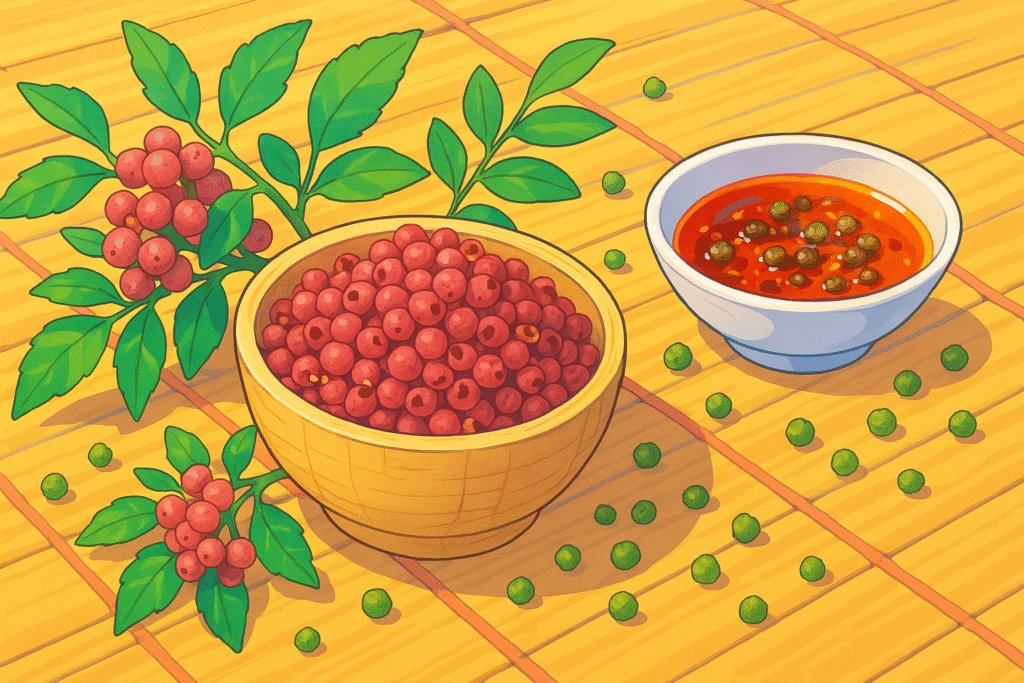Sichuan Pepper (Zanthoxylum simulans)

About Sichuan Pepper
Sichuan peppercorns (Zanthoxylum simulans) are neither related to black pepper nor true chili peppers. Instead, they are the dried husks of the prickly ash tree’s berries, delivering a signature “má” tingling sensation and lemony aroma. These vibrant pink-red husks offer more than just spice — their numbing, slightly citrusy effect transforms dishes with a complexity cherished in Chinese gastronomy. Essential in Sichuan cuisine’s famed “mala” flavor, they’re used whole, ground, or infused into oil for everything from mapo tofu to cold noodle salads. The unmistakable tingle makes Sichuan peppercorns stand out in the global spice landscape.
The History of Sichuan Pepper
Sichuan peppercorns have seasoned Chinese kitchens for millennia, with their first recorded use dating back to the Zhou dynasty (1046–256 BCE). Once prized for their medicinal properties, they became indispensable in Sichuan cooking, especially after chili peppers arrived from the Americas, giving rise to the iconic “mala” (numbing and spicy) style. Their reach extends beyond China into Tibetan thukpa soups, Japanese sanshō seasoning, and Nepalese momos. In some regions, Sichuan peppercorns were even used in ancient rituals to ward off evil or flavor fragrant teas. Their status as both a culinary and cultural staple remains unshaken, even despite occasional import bans in countries like the United States.
The Science of Sichuan Pepper
The signature numbing sensation springs from hydroxy-alpha-sanshool, a unique alkylamide compound concentrated in the berry’s husks. This molecule interacts with nerve receptors in the mouth, creating that odd but pleasant tingling familiar to fans of mala cuisine. Nutritionally, the peppercorns are rich in antioxidants, trace minerals, and volatile oils contributing to their citrus aroma. Despite their bold punch, they contain practically no capsaicin — the spicy compound in chilies — making their heat more about sensation than scoville units. Recent research has even explored sanshool’s potential in pain relief and sensory science.
The Geography of Sichuan Pepper
True Sichuan peppercorns thrive in the humid, mountainous regions of China’s Sichuan and Hunan provinces, where the prickly ash tree grows wild and cultivated. The region’s lush microclimate — marked by cool fog, fertile soils, and summer rains — develops bold, aromatic husks. Variations are found throughout East and Southeast Asia: In Japan, the related sanshō tree yields a green-hued, more floral cousin; in Nepal, timur peppercorns grow at high altitudes, exuding a resinous punch. Soil, rainfall, and altitude shape each variety’s signature aroma, heat, and flavor.
Varieties of Sichuan Pepper
Hua Jiao (Sichuan Red Peppercorns)
The classic type from Sichuan province, with a vibrant pinkish-red hue. Delivers a sharp numbing effect, lemony aroma, and hint of floral notes; a cornerstone of Chinese mala dishes.
Green Sichuan Peppercorn (Qing Hua Jiao)
Harvested earlier and less matured, these are sharp, zesty, and more citrus-forward than red peppercorns. Popular for delicate cold dishes and seafood in Western China.
Sanshō (Japanese Pepper)
Derived from Zanthoxylum piperitum, sanshō offers a cleaner, almost grapefruit-like zing, lighter numbing quality, and green color — a staple in Japanese grilled eel (unagi).
Timur Peppercorn (Nepalese Pepper)
Distinctly grapefruit-scented and piney, Nepal’s timur peppercorn is used in chutneys, pickles, and noodle dishes; its robust aroma and resinous bite set it apart regionally.
FAQs All your questions about Sichuan Pepper: answered
How do Sichuan peppercorns create a numbing sensation?
The numbing comes from hydroxy-alpha-sanshool, which stimulates tactile nerves in the mouth. This tricks the brain into perceiving tingling or buzzing, not actual heat.
Are Sichuan peppercorns spicy like chili peppers?
No — they actually contain no capsaicin, the chemical behind chili heat. Instead, they bring flavor, fragrance, and a unique numbing effect, not true peppery fire.
Can you substitute Sichuan peppercorns with anything else?
It’s difficult to perfectly replicate their flavor and tingle. Some cooks blend lemon zest with black pepper as a loose approximation, but the iconic numbing is unique to the genus Zanthoxylum.
Are Sichuan peppercorns toxic or unsafe?
No, but always use moderate amounts. Large quantities can cause digestive upset, and the strong tingling may overwhelm sensitive palates. Always sift out tough seeds before use, as they can be gritty and bitter.
Why were Sichuan peppercorns banned in some countries?
In the early 2000s, the United States temporarily banned their import over concerns about spreading citrus canker plant disease. The ban has since been lifted, but imported Sichuan peppercorns are now heat-treated for safety.